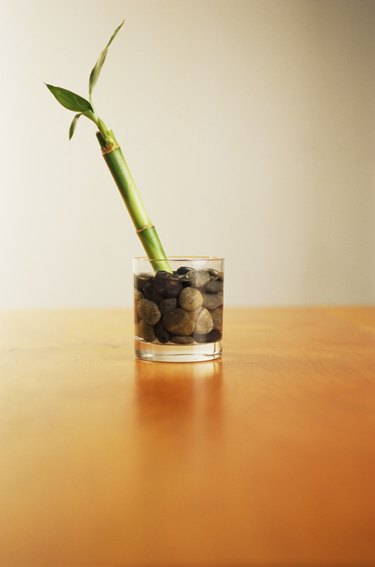
Lucky and Lotus Bamboos are not true bamboo plants, but are houseplants of the Dracaena species. Both are tropical plants native to Africa with slender stems or stalks and strap-like foliage. Lucky Bamboo (Dracaena sanderiana) is also called Ribbon Dracaena or Ribbon Plant for its long thin foliage. Lotus Bamboo (D. deremensis compacta or D. Deremensis "Janet Craig"), also known as Rose Bamboo or Flower Bamboo, is so named because the cluster of short leaves resembles a flower.
Planting
Video of the Day
Lucky and Lotus Bamboos are commonly grown in vases of water surrounded by pebbles or marbles for support. Since roots will grow from any part of the stalk that is submerged, the water should be kept at the same level – preferably 1 ½-2" deep. Numerous roots may cause poor plant growth due to overcrowding. In addition, the roots may be unattractive in a clear container. Dracaenas grow best when temperatures are between 65 and 95 degrees. Both prefer bright indirect light, but Lotus Bamboo needs more light than Lucky Bamboo. Good air circulation is essential to dry any accumulated moisture on the foliage and prevent diseases.
Video of the Day
Watering
Dracaenas are sensitive to fluoride in water, which may cause the leaf tips to turn brown. Use distilled or spring water to avoid fluoride damage. If you use tap water, let it stand overnight before using it. Change the water on Lucky Bamboo every 7 to 10 days and on Lotus Bamboo every month.
Fertilizing
Use an organic liquid fertilizer diluted according to the manufacturer's instructions on both types of plants. Synthetic fertilizers contain salts that may build up in the water and stress the plants. Fertilize Lucky Bamboo every two months and Lotus Bamboo every three to four weeks.
Problems
Direct sunlight may cause the tips of the leaves of Dracaenas to turn brown. Plants that do not receive enough light will turn yellow and have long thin stems. Cut off brown leaf tissue and yellow leaves with a sharp pair of scissors. Renew a stalk with a mushy brown bottom by cutting off the dead tissue and returning the green part of the stalk to the container. Yellowing stalks are dying or dead and need to be removed from the container. Remove any stalks with dead roots, which are black. Healthy Dracaena roots are orange or rust colored, while the new roots are white or cream colored. Wipe the stalks and leaves of the plants with a damp cloth to remove spider mites. If this does not get rid of the insects, use a mild insecticide approved for Dracaenas, according to the manufacturer's directions.